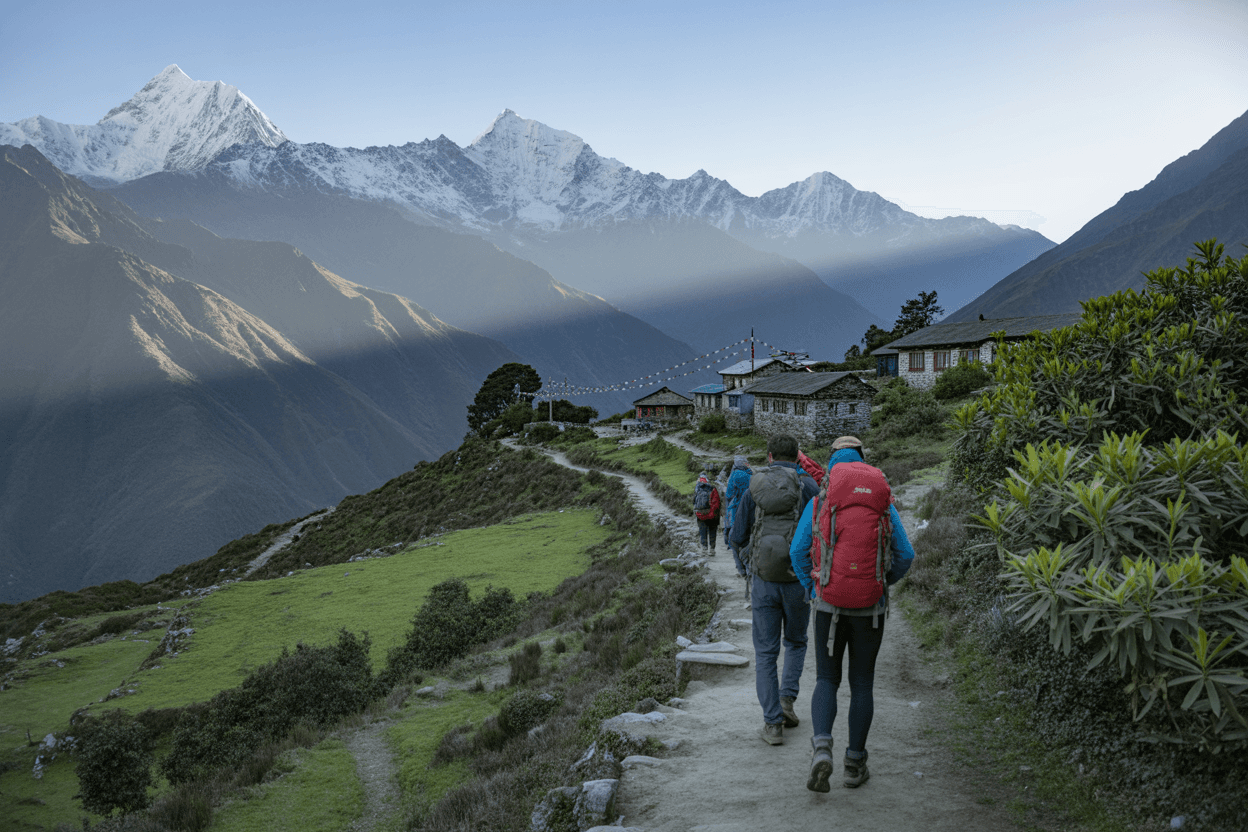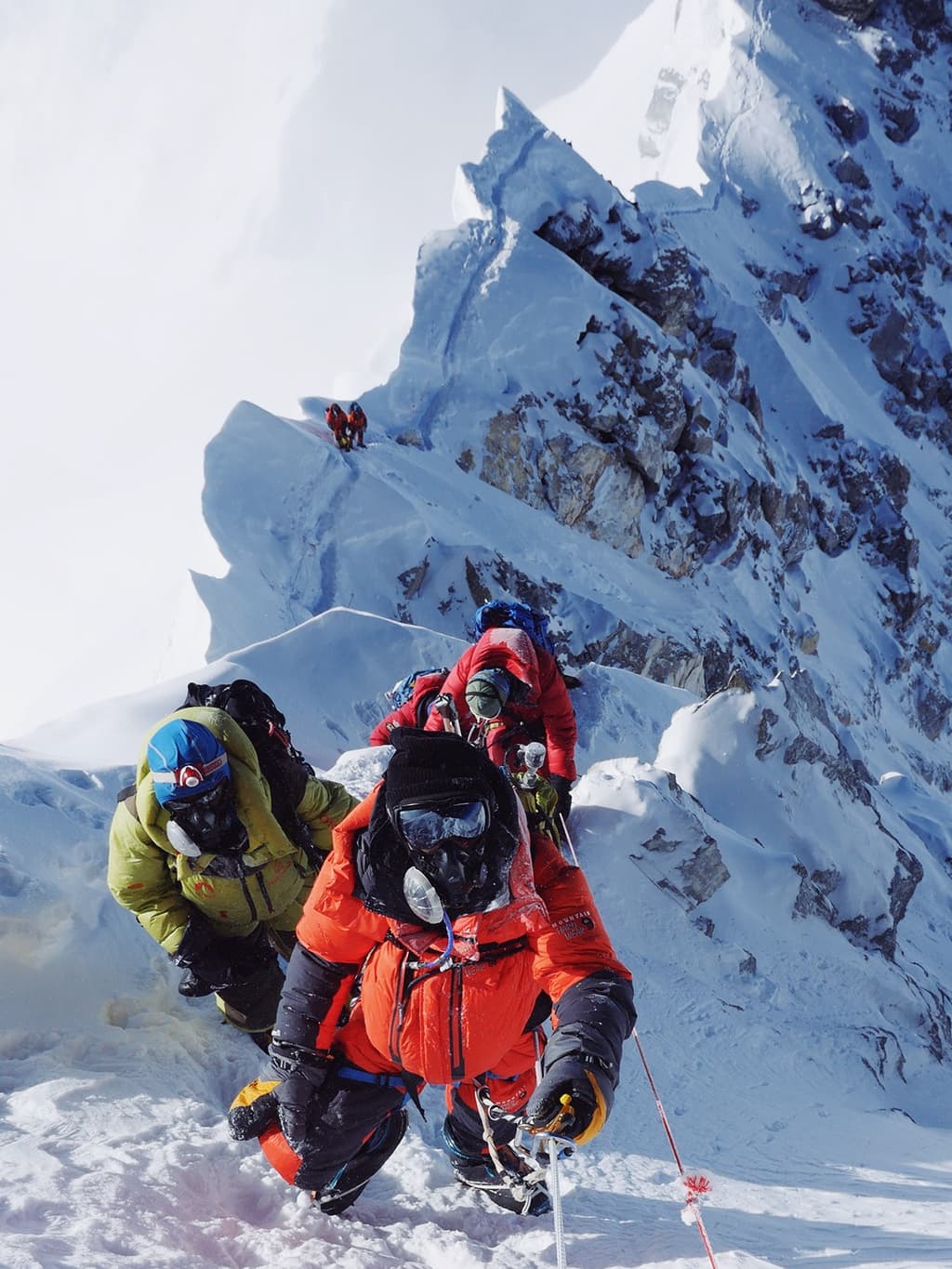The Langtang Valley Trek offers some of Nepal's most stunning mountain scenery without the crowds of Everest Base Camp or Annapurna Circuit. This comprehensive guide is perfect for first-time trekkers to Nepal, experienced hikers seeking a new challenge, and anyone wanting to explore authentic Tamang culture in the Himalayas.
Located just north of Kathmandu, this trek takes you through rhododendron forests, yak pastures, and traditional villages while offering spectacular views of Langtang Lirung and surrounding peaks. You'll discover everything from essential pre-trek preparation and detailed route options to managing high- altitude challenges and connecting with local communities. We'll also break down realistic budget expectations and transportation logistics to help you plan the perfect Himalayan adventure.
Essential Pre-Trek Planning and Preparation
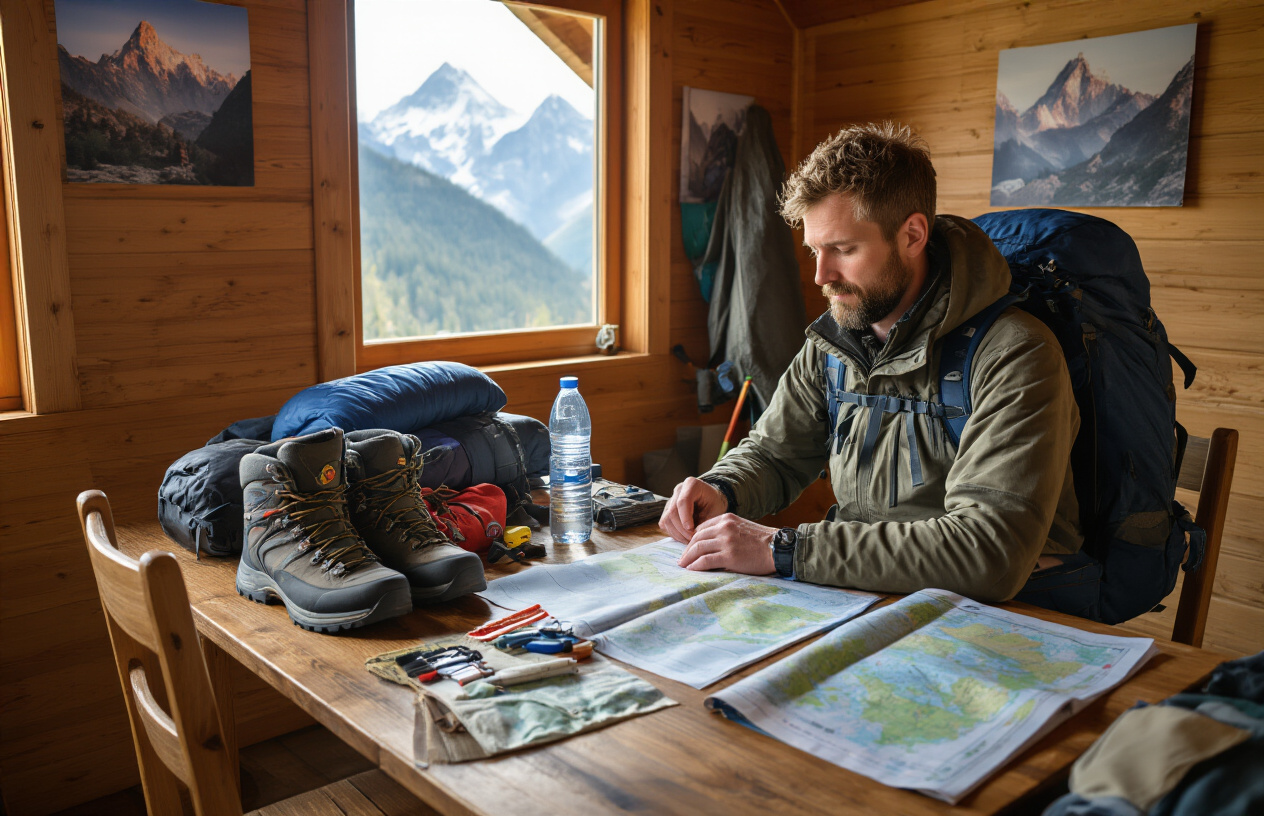
Best Time to Visit Langtang Valley for Optimal Weather
The weather plays a huge role in your trekking experience, and timing your visit right can make or break your adventure. Spring (March to May) stands out as the prime season, offering crystal-clear mountain views and comfortable daytime temperatures ranging from 15-20°C at lower elevations. The rhododendrons bloom during this period, painting the trails in vibrant reds and pinks that create a magical backdrop for your journey.
Autumn (October to November) comes in as a close second, delivering stable weather patterns and excellent visibility. The post-monsoon clarity provides spectacular mountain panoramas, though temperatures drop significantly, especially at night. Expect daytime temperatures around 10-15°C at mid- elevations, with nighttime temperatures plummeting below freezing at higher altitudes.
Winter trekking (December to February) presents unique challenges but rewards hardy adventurers with pristine snow-covered landscapes. Heavy snowfall can block higher passes, and temperatures can drop to -15°C or lower at altitude. Many teahouses close during this period, making logistics more complicated.
Monsoon season (June to September) brings heavy rainfall, leeches, and poor visibility. The trails become muddy and treacherous, while cloud cover obscures mountain views. Most experienced trekkers avoid this period entirely.
Required Permits and Documentation Process
Getting your permits sorted requires attention to detail and proper documentation. You'll need two essential permits for the Langtang Valley trek: the Langtang National Park Entry Permit and the TIMS (Trekkers' Information Management System) card.
The Langtang National Park Entry Permit costs NPR 3,000 (approximately $23) for foreign nationals and can be obtained at the Nepal Tourism Board office in Kathmandu or at the park entrance in Dhunche. You'll need your passport, two passport-sized photos, and a completed application form.
The TIMS card comes in two varieties: Individual Trekker (NPR 2,000/$15) and Group Trekker (NPR 1,000/$8). Individual trekkers must obtain the more expensive version if traveling without a registered guide. The card serves as a safety tracking mechanism and can be obtained from the Nepal Tourism Board or authorized trekking agencies.
Required documents include:
- Valid passport with at least 6 months remaining validity
- Nepal entry visa
- Travel insurance certificate covering helicopter rescue up to 5,000 meters
- Two recent passport-sized photographs
- Emergency contact information
Keep multiple photocopies of all documents in separate locations. Digital copies stored on your phone or cloud storage provide additional backup. Some checkpoints along the route verify permits, so keep originals easily accessible.
Physical Fitness Requirements and Training Tips
Don't underestimate the physical demands of this trek. While not technically challenging, the Langtang Valley trek requires solid cardiovascular fitness and leg strength to handle daily hiking distances of 4-8 hours across varied terrain.
Start your training at least 8-12 weeks before departure. Focus on building aerobic endurance through activities like hiking, running, cycling, or swimming. Aim for 4-5 training sessions per week, gradually increasing intensity and duration. Weekend hikes with a loaded backpack (10-15 kg) simulate actual trekking conditions.
Strength training should target your legs, core, and back muscles. Squats, lunges, calf raises, and step- ups build the leg power needed for steep ascents and descents. Planks and deadlifts strengthen your core and back for carrying a backpack comfortably.
Specific training recommendations:
- Week 1-4: Build base fitness with 30-45 minute cardio sessions
- Week 5-8: Increase intensity with interval training and longer hikes
- Week 9-12: Peak training with back-to-back long hikes and loaded carries
Practice hiking in your actual trekking boots to break them in and identify any fit issues. Test all gear during training hikes to ensure comfort and functionality. Mental preparation matters too – visualize challenging moments and develop coping strategies for fatigue and discomfort.
Gear and Equipment Checklist for Mountain Trekking
Proper gear selection can determine your comfort and safety throughout the trek. The layering system forms the foundation of your clothing strategy, allowing you to adapt to changing weather conditions and activity levels.
Essential Clothing:
- Moisture-wicking base layers (merino wool or synthetic)
- Insulating mid-layers (fleece or down jacket)
- Waterproof/breathable shell jacket and pants
- Trekking pants (quick-dry synthetic fabric)
- Warm hat and sun hat
- Liner gloves and insulated gloves
- Quality hiking socks (wool blend, bring 4-5 pairs)
Footwear:
- Waterproof trekking boots with ankle support
- Camp shoes (lightweight sandals or slip-ons)
- Gaiters for snow and debris protection
Technical Equipment:
- 40-50L trekking backpack with rain cover
- Sleeping bag rated to -10°C minimum
- Trekking poles for stability and joint protection
- Headlamp with extra batteries
- Water bottles or hydration system (3L total capacity)
- Water purification tablets or UV sterilizer
Personal Items:
- First aid kit with altitude sickness medication
- Sunscreen (SPF 30+) and lip balm
- Sunglasses with UV protection
- Personal toiletries and quick-dry towel
- Camera with extra batteries/power bank
- Cash in small denominations (NPR)
Pack weight should stay under 15-20% of your body weight. Choose lightweight, multi-purpose items when possible. Quality gear costs more upfront but performs better and lasts longer in harsh mountain conditions.
Complete Langtang Valley Trek Itinerary and Route Options
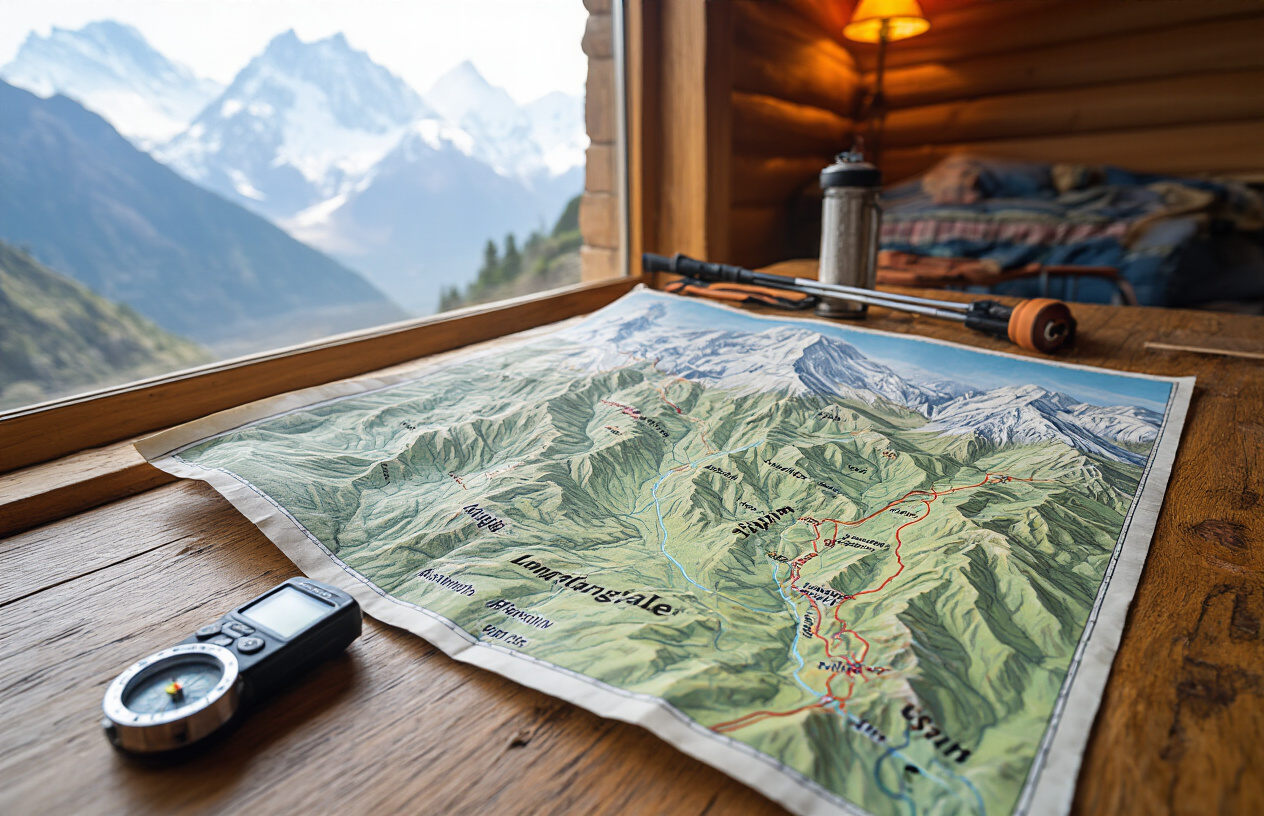
Standard 7-10 Day Trek Breakdown with Daily Distances
The classic Langtang Valley trek spans 7-10 days depending on your pace and acclimatization needs. Starting from Syabrubesi (1,550m), the journey unfolds through diverse landscapes and elevation gains.
Day 1: Syabrubesi to Lama Hotel (2,380m)
- Distance: 6-7 hours, 11km
- Gentle ascent through subtropical forests
- Cross several suspension bridges over the Langtang Khola
Day 2: Lama Hotel to Langtang Village (3,430m)
- Distance: 5-6 hours, 9km
- Steeper climb through bamboo and rhododendron forests
- First glimpse of snow-capped peaks
Day 3: Langtang Village to Kyanjin Gompa (3,870m)
- Distance: 3-4 hours, 7km
- Shorter day for proper acclimatization
- Dramatic mountain views emerge
Day 4: Acclimatization Day at Kyanjin Gompa
- Optional hike to Kyanjin Ri (4,773m) or Tserko Ri (5,000m)
- Essential rest day for altitude adjustment
- Explore the local yak cheese factory
Days 5-7: Return Journey
- Retrace steps to Syabrubesi
- Option to take different route via Thulo Syabru
- Faster descent allows for varied scenery appreciation
The 10-day version includes additional acclimatization time and side trips to viewpoints, making it ideal for photography enthusiasts and those wanting a more relaxed pace.
Alternative Shorter Routes for Time-Constrained Trekkers
Pressed for time? Several condensed versions maintain the trek's essence while fitting tighter schedules.
5-Day Express Route
This accelerated version combines stages but requires good fitness levels:
- Day 1: Syabrubesi to Langtang Village (challenging 8-9 hours)
- Day 2: Langtang Village to Kyanjin Gompa
- Day 3: Kyanjin exploration and viewpoint hikes
- Day 4: Kyanjin to Lama Hotel
- Day 5: Lama Hotel to Syabrubesi
6-Day Balanced Option
Perfect middle ground offering adequate rest without rushing:
- Splits the demanding first day into two manageable sections
- Includes one full day at Kyanjin for proper acclimatization
- Allows time for sunrise viewing from Kyanjin Ri
Helicopter Return Option
For ultimate time efficiency, trek up normally but helicopter out from Kyanjin Gompa. This saves 2-3 days while providing spectacular aerial views of the Himalayas. Though more expensive, it's popular among business travelers and those with limited vacation days.
Each shorter route requires better physical preparation since daily distances increase and rest opportunities decrease.
Extension Options to Gosaikunda Lake and Helambu
Transform your Langtang adventure into an epic 15-20 day journey by adding these stunning extensions.
Gosaikunda Lake Extension (Add 4-6 Days)
Sacred to both Hindus and Buddhists, Gosaikunda sits at 4,380m surrounded by dramatic peaks. The route branches from Dhunche or connects via Laurebinayak Pass (4,610m) from Kyanjin Gompa.
Key highlights include:
- Chain of 108 sacred lakes
- Pilgrimage site during Janai Purnima festival
- Challenging high-altitude pass crossing
- Panoramic Himalayan vistas
Helambu Circuit Connection (Add 6-8 Days)
This extension creates a spectacular loop through traditional Sherpa villages:
|
Route Section |
Duration |
Elevation Range |
Highlights |
|
Gosaikunda to Ghopte |
2 days |
4,380m-3,430m |
Alpine lakes, rhododendron forests |
|
Ghopte to Melamchigaon |
2 days |
3,430m-2,560m |
Sherpa culture, terraced fields |
|
Melamchigaon to Timbu |
2 days |
2,560m-1,650m |
Traditional villages, apple orchards |
Complete Circuit Benefits:
- No backtracking - entirely new scenery daily
- Cultural immersion in multiple ethnic communities
- Varied ecosystems from subtropical to alpine
- Less crowded trails compared to main Langtang route
This extended adventure requires excellent fitness, proper gear for high-altitude conditions, and flexible scheduling for weather delays. The reward? One of Nepal's most comprehensive trekking experiences combining natural beauty, cultural richness, and personal achievement.
Accommodation and Dining Along the Trekking Route
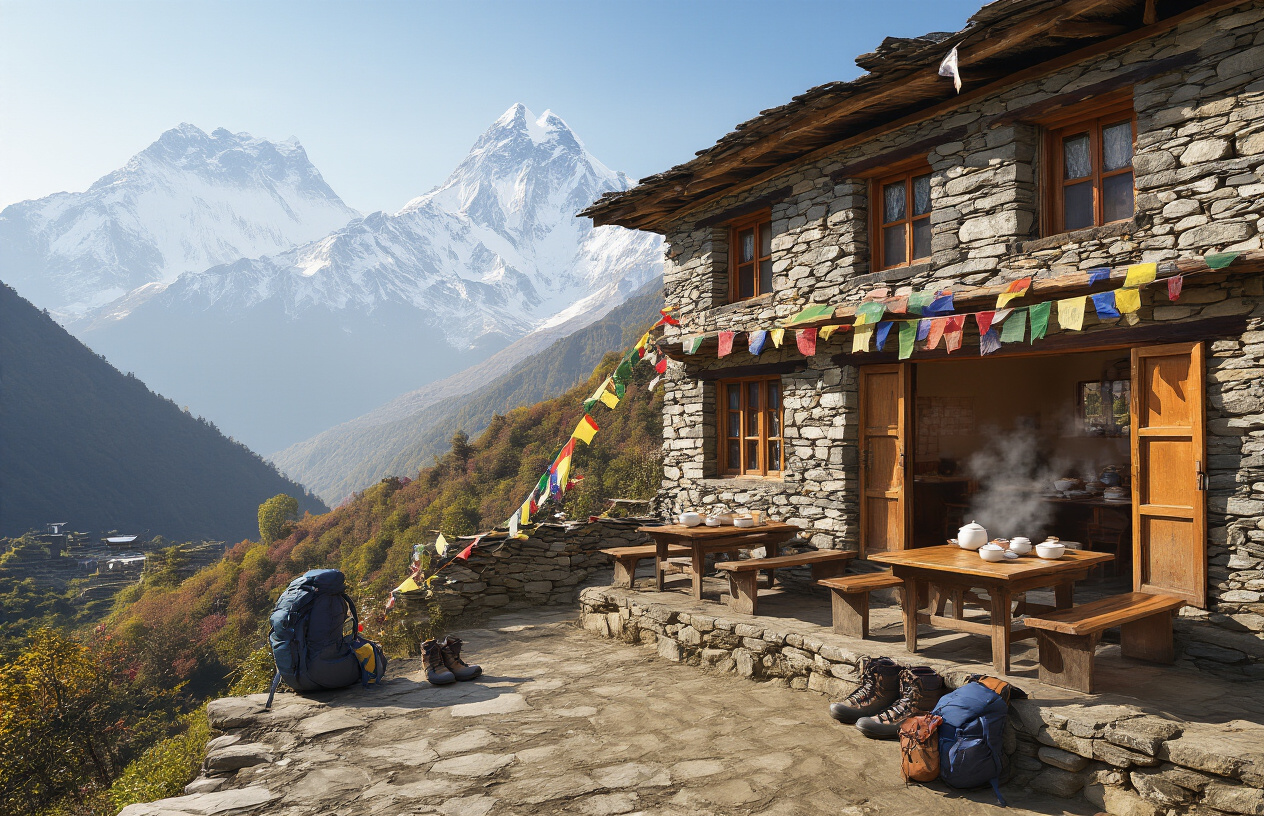
Teahouse Lodging Standards and What to Expect
Mountain teahouses along the Langtang Valley route offer basic but comfortable accommodation that perfectly suits the trekking environment. Most lodges provide twin-bedded rooms with shared bathrooms, though some higher-end establishments offer private bathrooms in popular stops like Kyanjin Gompa.
Rooms typically feature simple wooden beds with foam mattresses, basic bedding, and minimal furniture.
Expect thin walls and limited insulation, making a good sleeping bag essential for warmth. Heating is usually available in common areas through wood-burning stoves, but individual rooms remain unheated. Most teahouses provide electricity, though power may be intermittent and often shuts off by 9 PM. Charging devices costs extra, typically 200-500 NPR per hour.
Hot showers are available at most lodges for 300-800 NPR, though water pressure and temperature can be inconsistent. Some places offer solar-heated water, which works best during sunny afternoons. Wi-Fi is increasingly common but expect slow speeds and additional charges of 300-500 NPR per day.
Room rates range from 500-1,500 NPR per night, with prices increasing at higher altitudes. During peak seasons (October-November and March-May), advance booking becomes important, especially for popular stops like Langtang Village and Kyanjin Gompa. The lodge owners are typically welcoming local families who take pride in their hospitality.
Local Cuisine Highlights and Meal Costs
The dining experience along the Langtang Valley trek combines traditional Nepali and Tibetan flavors with international trekking favorites. Dal bhat (lentil soup with rice) serves as the cornerstone meal, offering unlimited refills and costing 800-1,200 NPR. This nutritious combination provides excellent energy for trekking and represents the best value for money.
Tibetan specialties dominate the menu, including momos (steamed dumplings) for 400-600 NPR, thukpa (noodle soup) for 500-800 NPR, and gundruk soup (fermented leafy greens) for 300-500 NPR. These warming dishes are perfect after long trekking days and showcase authentic regional cooking techniques.
International options cater to diverse tastes, with fried rice (600-900 NPR), pasta dishes (700-1,000 NPR), and pancakes (400-700 NPR) widely available. Pizza appears on many menus for 1,000-1,500 NPR, though don't expect Italian authenticity at 4,000 meters elevation.
Breakfast options include porridge (400-600 NPR), eggs in various preparations (300-500 NPR), and Tibetan bread (200-400 NPR). Hot beverages like milk tea (150-300 NPR), coffee (300-500 NPR), and hot chocolate (400-600 NPR) provide essential warmth and comfort.
Meal prices increase with altitude, with Kyanjin Gompa being notably more expensive than lower villages. Expect to budget 2,500-3,500 NPR per day for three meals and beverages.
Food Safety Tips for High-Altitude Dining
Maintaining food safety becomes critical at high altitudes where your body already faces additional stress. Choose freshly cooked, hot meals over pre-prepared items sitting at room temperature. Dal bhat represents the safest option since it's prepared fresh and served piping hot, minimizing bacterial risks.
Avoid raw vegetables and fruits unless you can peel them yourself. Lettuce, tomatoes, and other raw garnishes carry higher contamination risks, especially when washed with local water. Stick to cooked vegetables and fruits with thick peels like oranges and bananas.
Water safety requires constant attention. Drink only boiled, bottled, or properly purified water. Tea and coffee prepared with boiling water are generally safe options. Many trekkers bring water purification tablets or UV sterilizers as backup methods. Avoid ice cubes and drinks mixed with tap water.
Choose busy teahouses with high food turnover, ensuring fresher ingredients and faster consumption of prepared meals. Popular lodges typically maintain better hygiene standards due to higher customer expectations and regular inspections.
Pay attention to your body's signals at altitude. Your digestion may slow down, making lighter meals more appropriate than heavy, rich foods. Spicy dishes that you normally enjoy might cause additional stomach upset when combined with altitude effects.
Carry basic medications including anti-diarrheal tablets, oral rehydration salts, and stomach acid reducers. Pack these items before starting the trek since medical supplies become scarce at higher elevations.
Transportation and Getting to the Trailhead
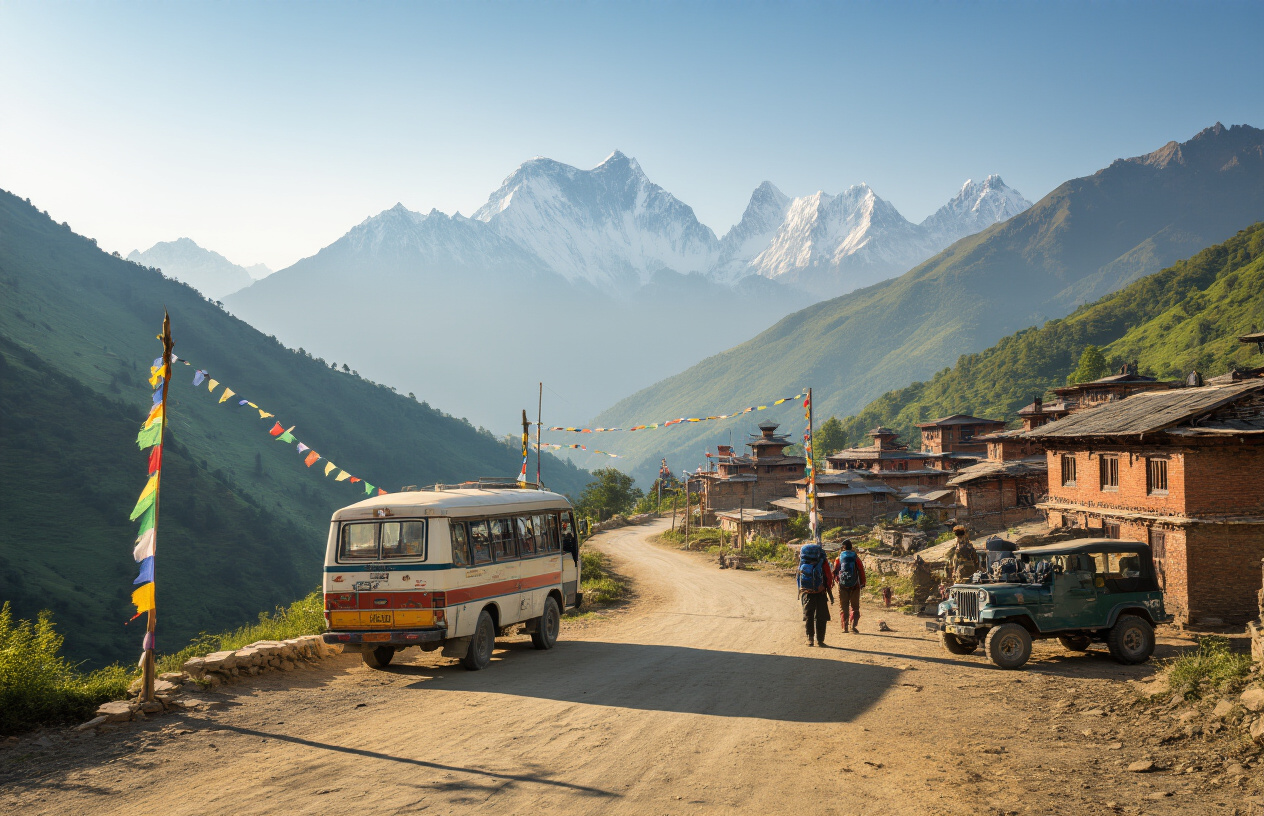
Kathmandu to Syabrubesi Travel Options and Costs
Getting from Kathmandu to Syabrubesi, the starting point for the Langtang Valley Trek, involves a scenic but challenging mountain road journey. You have several transportation options, each with distinct advantages and price points.
Local Bus Service
Public buses depart daily from Kathmandu's Machhapokhari Bus Station around 7:00 AM. The journey takes 7-8 hours and costs approximately NPR 400-600 ($3-5 USD). These buses make frequent stops for passengers and meals, extending travel time but offering authentic local experiences. Expect basic seating and crowded conditions, especially during peak trekking seasons.
Private Jeep or Car
Hiring a private vehicle costs NPR 12,000-18,000 ($90-135 USD) and reduces travel time to 6-7 hours. You'll have flexibility with stops, comfortable seating, and luggage space. Many trekkers share costs by organizing group transport through their accommodation or trekking agencies.
Shared Jeep
A middle-ground option costing NPR 1,500-2,500 ($11-19 USD) per person. These depart from Machhapokhari when full (typically 10-12 passengers) and take 6-7 hours. Book through local travel agents or arrive early to secure seats.
Microbus Services
Some operators run daily microbus services for NPR 800-1,200 ($6-9 USD) per person, offering better comfort than public buses while remaining budget-friendly. Seats fill quickly during peak seasons, so advance booking is recommended.
Local Bus vs Private Transport Comparison
| Transport Type | Cost (USD) | Duration | Comfort Level | Flexibility | Best For |
| Local Bus | $3-5 | 7-8 hours | Basic | Low | Budget travelers, cultural immersion |
| Shared Jeep | $11-19 | 6-7 hours | Moderate | Low-Medium | Mid-range budget, small groups |
| Private Vehicle | $90-135 | 6-7 hours | High | Very High | Comfort seekers, larger groups |
| Microbus | $6-9 | 6-8 hours | Good | Low | Budget-conscious with comfort needs |
Comfort and Convenience Factors
Local buses offer the most authentic experience but come with hard seats, frequent stops, and unpredictable schedules. The road to Syabrubesi is winding and dusty, making the journey physically demanding in basic transport. Private vehicles provide air conditioning, cushioned seats, and the ability to stop for photos or rest breaks when needed.
Booking and Availability
During peak seasons (March-May and September-November), advance booking becomes essential for all transport options. Private vehicles require 1-2 days notice, while shared transport can often be arranged the day before departure. Local buses rarely require advance booking but may sell out during festivals or peak trekking periods.
Return Journey Planning and Backup Options
Planning your return journey requires flexibility, as mountain weather and road conditions can change rapidly. Most trekkers complete the standard Langtang Valley circuit in 7-12 days, but having backup plans prevents being stranded.
Standard Return Schedule
Book return transport for 1-2 days after your planned trek completion. This buffer accounts for weather delays, altitude adjustment needs, or simply wanting extra time in the mountains. Most transport operators allow date changes with 24-48 hours notice.
Emergency Evacuation Routes
The primary route back to Kathmandu follows the same Syabrubesi path, but several alternatives exist during road closures:
- Helicopter evacuation from Kyanjin Gompa costs $3,000-5,000 USD for emergency situations
- Alternative trekking routes connect to different road heads, though these require additional days
- Delayed departure from Syabrubesi until roads clear, which may take 1-3 days during monsoon season
Contingency Transport Arrangements
Keep contact information for multiple transport providers in Syabrubesi. Local lodge owners and guides maintain relationships with reliable drivers who can arrange emergency transport. Always carry extra cash for unexpected transport costs, as card payments aren't accepted in remote areas.
Weather-Related Delays
Landslides frequently block the Syabrubesi road during monsoon season (June-September). Heavy snowfall can also close passes during winter months. Monitor weather forecasts and maintain communication with your accommodation in Kathmandu about potential delays.
Airport Transfer Coordination
Coordinating airport transfers with your Langtang trek requires careful timing, especially for international flights with strict departure schedules.
Pre-Trek Airport Pickup
Most Kathmandu hotels and guesthouses offer airport pickup services for NPR 500-1,500 ($4-11 USD). Confirm pickup details 24 hours before arrival, including driver contact information and meeting points. Traffic congestion can delay airport transfers by 1-2 hours during peak times.
Post-Trek Airport Departure
Allow minimum 24 hours buffer between returning from Syabrubesi and international flight departures. Mountain roads can experience unexpected delays, and you may need recovery time after the trek. Book flexible airport transfer services that accommodate schedule changes.
Luggage Storage Solutions
Most Kathmandu accommodations offer luggage storage while you trek, allowing you to pack light for the mountains while keeping extra clothes and items for your departure. Some trekking agencies also provide secure storage facilities.
Last-Minute Flight Changes
Keep airline contact information accessible and understand change policies. Mountain trekking occasionally requires itinerary adjustments that affect departure dates. Travel insurance typically covers reasonable flight change fees due to weather-related delays in mountainous regions.
Direct Airport Transport
In emergency situations, private vehicles can drive directly from Syabrubesi to Tribhuvan International Airport in 5-6 hours, though this costs NPR 20,000-25,000 ($150-190 USD) and should only be used for urgent departures.
Safety Considerations and High-Altitude Health Management
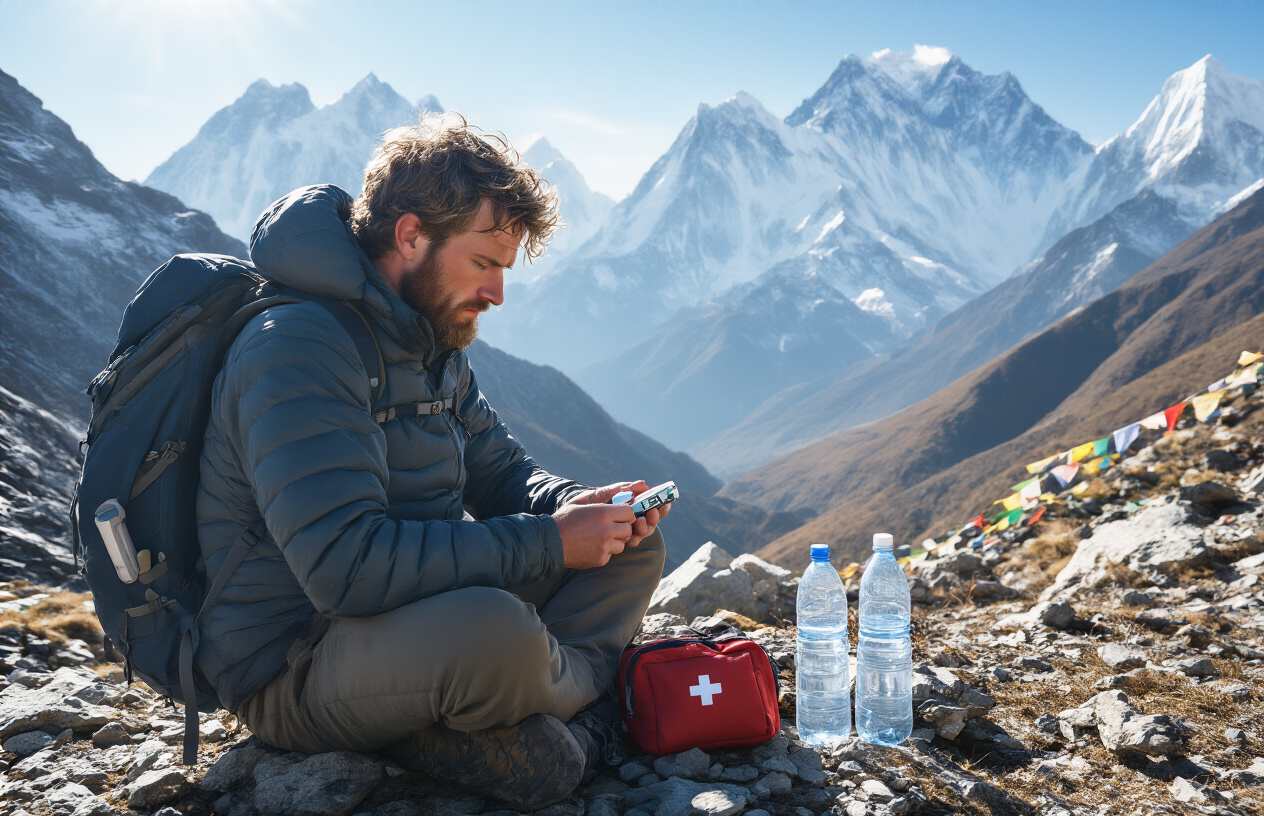
Altitude Sickness Prevention and Recognition
Your body needs time to adjust to the thin air above 3,000 meters, and the Langtang Valley trek takes you well beyond this threshold. The golden rule for altitude acclimatization is "climb high, sleep low" – gain altitude during the day but return to lower elevations for sleeping when possible.
Key Prevention Strategies:
- Ascend no more than 300-500 meters per day above 3,000 meters
- Include rest days every 3-4 days of climbing
- Stay hydrated with 3-4 liters of water daily
- Avoid alcohol and sleeping medications
- Eat high-carbohydrate meals to fuel your body
Recognizing the Warning Signs:
Mild altitude sickness symptoms include headaches, nausea, fatigue, and difficulty sleeping. These usually resolve with rest and proper hydration. However, watch for serious symptoms that require immediate descent: severe headaches that don't respond to painkillers, vomiting, confusion, loss of coordination, or difficulty breathing at rest.
High Altitude Cerebral Edema (HACE) presents with severe confusion, hallucinations, and loss of coordination. High Altitude Pulmonary Edema (HAPE) causes extreme breathlessness, chest tightness, and pink frothy cough. Both conditions are life-threatening and demand immediate evacuation to lower altitudes.
Carry altitude sickness medication like Diamox (acetazolamide) after consulting your doctor. Some trekkers benefit from starting the medication 1-2 days before reaching altitude, but this should be discussed with a healthcare professional familiar with high-altitude medicine.
Emergency Evacuation Procedures and Insurance Requirements
Emergency evacuation from the Langtang Valley can be complex and expensive, making comprehensive insurance absolutely essential. Helicopter rescue is the primary evacuation method, but weather conditions often prevent flights for days.
Insurance Must-Haves:
- Coverage for helicopter evacuation up to 6,000 meters
- Medical treatment costs of at least $100,000
- Emergency repatriation to your home country
- Adventure sports coverage that specifically includes trekking
- 24/7 emergency assistance hotline
Popular insurance providers for Nepal trekking include World Nomads, IMG Global, and Cigna Global. Read the fine print carefully – some policies exclude coverage above certain altitudes or require professional guide accompaniment.
Evacuation Process:
Contact your insurance company immediately when an emergency occurs. They coordinate with local rescue services and handle payment authorization. Keep all medical receipts and documentation. Helicopter evacuations typically cost $3,000-$5,000 per flight, and weather delays can multiply these costs.
Register with your embassy before trekking and inform them of your planned route. Carry emergency contact information for the nearest police post, health clinic, and helicopter landing sites. The Langtang area has evacuation points at Kyanjin Gompa and several locations along the main trail.
Communication Options and Connectivity in Remote Areas
Don't expect to post Instagram updates from every viewpoint – connectivity in the Langtang Valley is sporadic and expensive. Most teahouses offer WiFi, but speeds are painfully slow and costs range from $2-5 per hour.
Communication Options:
Mobile Networks: Ncell and Nepal Telecom provide the best coverage, reaching most villages along the main trail. Purchase local SIM cards in Kathmandu before starting your trek. Data packages are affordable but speeds drop significantly at higher altitudes.
Satellite Communication: For serious emergencies, consider renting a satellite phone or GPS communicator like Garmin inReach. These devices work anywhere with clear sky view and can send emergency messages even when unconscious (some models).
Internet Cafes: Available in larger villages like Langtang and Kyanjin Gompa, typically charging $3-5 per hour with very slow connections.
Communication Tips:
- Download offline maps before starting your trek
- Inform family/friends of communication blackout periods
- Save emergency numbers in your phone before losing signal
- Carry a portable battery pack – charging opportunities are limited
- Write down important phone numbers on paper as backup
Many trekkers find the communication limitations liberating, allowing complete immersion in the mountain experience. Plan accordingly and set expectations with people back home about irregular contact.
Weather-Related Safety Precautions
Mountain weather in the Langtang Valley changes rapidly and can turn dangerous without warning. The region experiences distinct seasons with unique challenges that require different preparation strategies.
Seasonal Weather Patterns:
Spring (March-May): Generally stable weather with clear mountain views, but afternoon thunderstorms are common. Temperatures range from comfortable during the day to freezing at night above 4,000 meters.
Monsoon (June-September): Heavy rains make trails slippery and dangerous. Leeches become a significant problem, and mountain views are often obscured by clouds. Many lodges close during peak monsoon months.
Autumn (October-December): The most popular trekking season with stable weather and crystal-clear mountain views. Temperatures drop significantly, especially at higher elevations.
Winter (January-February): Extremely cold with heavy snow above 3,500 meters. Many high-altitude lodges close, and avalanche risk increases substantially.
Safety Precautions:
- Check weather forecasts before departing each day
- Start early to avoid afternoon storms
- Carry waterproof gear regardless of season
- Know locations of emergency shelters along the route
- Turn back immediately if weather deteriorates
- Carry extra warm layers – temperatures can drop 20°C with weather changes
Lightning strikes are a real danger during thunderstorms. Avoid ridges, metal objects, and tall trees. If caught in the open, crouch low on the balls of your feet.
Solo vs Group Trekking Safety Comparison
The choice between solo and group trekking significantly impacts your safety profile in the Langtang Valley. Each approach offers distinct advantages and risks that you should weigh carefully.
|
Aspect |
Solo Trekking |
Group Trekking |
|
Emergency Response |
Delayed help, self-reliant |
Immediate assistance available |
|
Decision Making |
Complete autonomy |
Group consensus required |
|
Cost |
Higher per-person expenses |
Shared costs reduce individual burden |
|
Flexibility |
Maximum route/schedule flexibility |
Limited by group dynamics |
|
Cultural Interaction |
Deeper local connections |
Insulated group experience |
Solo Trekking Advantages:
- Complete flexibility in pace and route changes
- Deeper cultural immersion with local communities
- Personal challenge and self-discovery opportunities
- Freedom to extend or shorten the trek based on conditions
Solo Trekking Risks:
- No immediate help during emergencies
- Higher accommodation and guide costs
- Increased risk during river crossings or difficult terrain
- Limited local knowledge without experienced companions
Group Trekking Benefits:
- Shared safety responsibilities and emergency support
- Cost-effective with shared guide and porter fees
- Collective decision-making during challenging conditions
- Built-in companionship and motivation
Group Trekking Drawbacks:
- Pace dictated by slowest member
- Limited flexibility for route modifications
- Potential personality conflicts in stressful situations
- Reduced opportunities for authentic cultural exchanges
Safety Recommendations:
Solo trekkers should hire experienced local guides familiar with current trail conditions and emergency procedures. The additional cost is worthwhile for the safety margin and local knowledge. Group trekkers should establish clear emergency protocols and ensure at least one member has wilderness first aid training.
Regardless of your choice, inform someone reliable about your detailed itinerary and expected return date. Carry emergency communication devices if trekking solo, and ensure your travel insurance covers your chosen trekking style.
Cultural Experiences and Local Community Interactions
Tamang Heritage and Traditional Village Life
The Langtang Valley trek takes you deep into the heart of Tamang country, where ancient traditions remain beautifully preserved despite the modern world's encroachment. These resilient communities have called the high valleys home for centuries, creating a unique cultural tapestry that blends Tibetan Buddhism with their own distinct practices.
Walking through villages like Langtang and Kyanjin Gompa, you'll witness daily life that follows rhythms unchanged for generations. Women weave colorful textiles on traditional looms while men tend to yaks and maintain stone-walled fields. The traditional architecture tells its own story - flat-roofed houses built from local stone and timber, designed to withstand harsh mountain winters while maximizing precious sunlight.
Tamang hospitality shines through shared meals of dal bhat and butter tea, where conversation flows despite language barriers. Elders often share stories of their ancestors' migrations from Tibet, while younger generations balance respect for tradition with dreams of education and opportunity. Village festivals bring communities together with masked dances, singing, and celebrations that can last for days.
The earthquake of 2015 devastated many villages, but the rebuilding process has showcased remarkable community solidarity. You'll see reconstruction efforts that blend traditional building techniques with improved earthquake-resistant methods, creating structures that honor the past while preparing for the future.
Monastery Visits and Buddhist Cultural Insights
Buddhist monasteries scattered throughout the valley serve as spiritual anchors for local communities and fascinating windows into Himalayan religious practices. Kyanjin Gompa monastery stands as the trek's most accessible religious site, where morning and evening prayers create an atmosphere of profound tranquility against the backdrop of snow-capped peaks.
The monastery's prayer halls house ancient Buddhist texts, intricate mandalas, and statues of protective deities that watch over the valley. Monks welcome respectful visitors, often sharing insights about their daily practices, meditation techniques, and the role Buddhism plays in mountain life. The spinning of prayer wheels, burning of juniper incense, and chanting of mantras create sensory experiences that connect you to centuries-old spiritual traditions.
Prayer flags flutter from every ridgeline, their faded colors carrying wishes and blessings across the mountains. Each color represents different elements - blue for sky, white for air, red for fire, green for water, and yellow for earth. These flags aren't just decorative; they're active participants in the spiritual life of the valley, believed to spread compassion and good fortune with every flutter.
Local festivals often center around monastery celebrations, where communities gather for elaborate ceremonies featuring traditional music, masked dances, and shared feasts. These events offer rare glimpses into the intersection of daily life and deep spiritual practice that defines Himalayan Buddhist culture.
Local Handicrafts and Authentic Souvenir Shopping
The Langtang Valley offers genuine opportunities to purchase handicrafts directly from the artisans who create them, supporting local economies while taking home authentic pieces of mountain culture. Unlike touristy markets in Kathmandu, valley shopping happens in homes and small workshops where you can watch craftspeople at work.
Tamang women excel at textile production, creating beautiful woolen items using traditional techniques passed down through generations. Hand-knitted sweaters, caps, and mittens made from local yak wool provide both warmth and cultural connection. The natural colors come from local plants and minerals, creating subtle earth tones that reflect the mountain environment.
Wooden items carved from local timber make practical and meaningful souvenirs. Prayer wheels, small Buddha statues, and traditional cups showcase skilled craftsmanship while serving functional purposes. Many pieces feature intricate Buddhist symbols and mantras that carry spiritual significance beyond their aesthetic appeal.
| Item Type | Price Range (USD) | Best Villages to Buy |
| Yak Wool Sweaters | $15-30 | Langtang, Kyanjin |
| Hand-knitted Caps | $5-12 | All valley villages |
| Wooden Prayer Wheels | $8-20 | Kyanjin Gompa |
| Traditional Jewelry | $10-40 | Langtang, Gatlang |
Shopping in the valley requires patience and respect for local customs. Bargaining happens gently, more like friendly conversation than aggressive negotiation. Many purchases come with stories about the creation process, cultural significance, or family traditions, adding immeasurable value to your souvenirs.
Budget Planning and Cost Breakdown
Daily Expense Estimates for Different Comfort Levels
Your daily spending in the Langtang Valley depends heavily on your comfort preferences and altitude. Budget trekkers can expect to spend $15-25 per day, covering basic teahouse accommodation ($3-8), simple meals ($8-12), and occasional snacks. Mid-range trekkers typically spend $25-40 daily, enjoying better rooms with attached bathrooms when available ($8-15) and more varied meal options including some imported items.
Luxury trekkers, while limited by remote location constraints, can spend $40-60 daily by choosing premium teahouses, ordering higher-end meals, and purchasing additional comfort items. Prices increase significantly with altitude - expect 20-30% higher costs above Kyanjin Gompa compared to lower villages like Langtang.
| Comfort Level | Accommodation | Meals | Daily Total |
| Budget | $3-8 | $8-12 | $15-25 |
| Mid-range | $8-15 | $15-20 | $25-40 |
| Luxury | $15-25 | $20-30 | $40-60 |
Peak season (March-May, October-November) adds 15-20% to these estimates, while monsoon season offers slight discounts but comes with challenging trail conditions.
Porter and Guide Service Costs
Hiring a guide costs $20-30 per day for experienced professionals who speak English well and know the region intimately. Local guides typically charge $15-25 daily, perfect for budget-conscious trekkers who want cultural insights without premium services. Guide costs include their food and accommodation, which you'll pay at teahouses.
Porter services run $15-20 daily for carrying up to 20kg of gear. Many trekkers hire a porter-guide combo at $25-35 per day - someone who carries your pack and provides basic route guidance. This arrangement works well for solo trekkers or small groups wanting to reduce costs while maintaining support.
Always verify that porter wages include their insurance, proper gear, and fair working conditions. Reputable agencies provide this transparency, while cheaper options might exploit workers. Factor in tips of $3-5 per day for good service, typically given at trek completion.
Hidden Costs and Money-Saving Strategies
Several unexpected expenses can inflate your budget significantly. Hot showers cost $2-5 each, WiFi access runs $2-3 per day, and device charging fees range from $1-3 per charge. Bottled water becomes expensive at higher altitudes ($2-4 per bottle), while water purification tablets or UV sterilizers offer long- term savings.
Emergency expenses like helicopter evacuation ($3,000-8,000) underscore the importance of comprehensive travel insurance. Medical consultations in remote areas can cost $50-100, making a basic first-aid kit essential.
Money-saving strategies include:
- Bringing your own snacks and energy bars
- Using water purification instead of buying bottles
- Sharing accommodation with fellow trekkers
- Eating local dal bhat (often unlimited refills)
- Trekking during shoulder seasons for lower prices
- Booking direct with teahouses rather than through agencies
Payment Methods and ATM Availability
Cash remains king in the Langtang Valley, with Nepali rupees being the only accepted currency. The last reliable ATM is in Dhunche, though it frequently runs out of cash or experiences technical issues.
Syabrubesi has one ATM, but it's notoriously unreliable.
Bring all your cash from Kathmandu - exchange rates in remote areas are unfavorable when currency exchange is even available. Most teahouses accept small denomination bills better than large ones, so request 100 and 500 rupee notes when exchanging money.
Credit cards work nowhere along the trek route. Some higher-end teahouses in Kyanjin Gompa claim to accept cards, but technical failures are common. Digital payment apps like eSewa or Khalti have limited acceptance and require Nepali bank accounts.
Plan for $300-500 in cash for a 7-10 day trek, depending on your comfort level and group size. Keep money in multiple locations - some in your main bag, some in your day pack, and emergency cash in a separate secure location. Small bills (10, 20, 50 rupee notes) prove most useful for tips and small purchases.
Conclusion
The Langtang Valley Trek offers an incredible blend of natural beauty, cultural richness, and adventure that's hard to find elsewhere in Nepal. From planning your journey and choosing the right route to managing high-altitude challenges and connecting with local communities, every aspect of this trek contributes to an unforgettable experience. The combination of stunning mountain views, authentic Tamang culture, and relatively accessible trails makes this region perfect for both seasoned trekkers and those new to Himalayan adventures.
Smart preparation is your ticket to a successful trek. Budget wisely, respect the local culture, listen to your body at higher altitudes, and stay flexible with your plans. The memories you'll create walking through rhododendron forests, sharing tea with local families, and watching sunrise over the Langtang peaks will last a lifetime. Pack your bags, lace up those boots, and get ready to discover one of Nepal's most rewarding trekking destinations.
